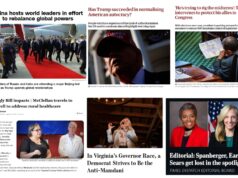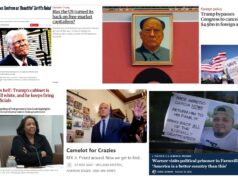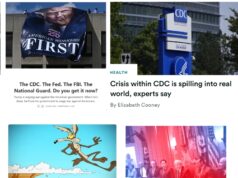Man, do we ever need a governor like Maryland’s Martin O’Malley here in Virginia. Yesterday, O’Malley laid out his plan (see video, also transcript on the “flip”) to cut his state’s greenhouse gas emissions by 25 percent, to “reduce per capita electricity consumption and peak demand by Maryland consumers by 15 percent by 2015,” and to “require 25 percent renewable energy consumption by 2020” (up from the current goal of 22% by 2022).
Can you imagine Bob McDonnell giving this speech? How about Ken Cuccinelli, beholden as he is to the Koch brothers, Consol Energy, the coal companies, etc, etc? Yeah right. I have a lot more hope for Terry McAuliffe, who is passionate about clean energy, but even a Governor McAuliffe will need help from the Virginia General Assembly, and right now that body is controlled by a bunch of climate-science-denying, fossil-fuel-addicted Teapublicans. That has to change, starting on November 5 of this year, as we start the process of making Virginia’s government reflect the increasingly “blue” (and also “green”) political stance of the populace.
P.S. Also, can you imagine Ken Kookinelli stating the truth that climate change “is not an ideological issue any more than gravity is,” that it “is physics, pure and simple?”
Thank you very, very much for taking the time to be here today. I look around at this audience and I see the great strength that is our state- people who rise to the tough challenges instead of running away from them. Thank you to our Majority Leader Kumar Barve, our State’s Chairman of Progress. Thank you to all of the members of the General Assembly, Democrats and Republicans, who are with us today. And again I want to thank all of you.
We’ve been able to accomplish some really important things in some of the toughest economic times. And you all should take some heart in that in what you have in one another. And what we have in each other.
There are not many states that have been able to make the progress that we’ve made. But part of the reason we’ve been able to make that progress is because we’ve been honest not only about the challenges we face but also in measuring them as openly and as accurately as we can; the pace of that progress, whether things are working or not working; and the degree to which they are working or not working.
This work is hard. It is not easy. It is life and death hard.
We are here today because climate disruption is real. It is not an ideological issue any more than gravity is. [Applause] It is physics, pure and simple. But our response to it is complex.
No state can escape the urgent responsibility of this moment. In fact, throughout our Great Revolutionary history, it is in exactly in moments like these, when Marylanders have always chosen to step up and to move ahead and that’s why we are here today.
We are here today because we understand deep in our hearts that we do have a moral obligation to our children and to our grandchildren to give to them a planet that is not on the trajectory that we currently find ourselves in. A planet that is becoming increasingly more damaged, more polluted, more unhealthy.
The fierce urgency of these times, calls on all of us to move forward in this great change in human history. For all of our technological advances in transportation and the economies of extraction and depletion, the great challenge of our time is to move and shift especially when it comes to food and energy efficiency. We need to move from global economies of extraction to local economies of renewal and local economies of regeneration.
In order to do this we have to embrace a different way forward. Not ideological, hierarchical or bureaucratic but entrepreneurial, collaborative, performance-driven in terms of the way we live, in terms of the way we act and in terms of the way we lead.
If we want better results we have to make better choices.
The Problem
Facts are facts. The carbon content of our earth’s atmosphere is higher now than it has been at any time in 3 million years.
And there’s no coincidence that last year, there were more than 3,500 national weather records broken for heat, rain, and snow.
Nationally, 12 of the hottest years on record have occurred in just the last 15 years.
In our northeastern region, last year we experienced the hottest year on record.
These are not opinions; these are measures. They are facts agreed upon by 98% of the scientific community regardless of party affiliation.And this is not only about icebergs melting, or polar bears drowning.
It’s also, more locally, about the 168 Marylanders we’ve lost in severe weather events over the past decade and a half.
It’s about children who suffer from Asthma, a leading cause of absenteeism in our elementary schools. It’s about moms and dads rushed to the emergency room with heat stress. And it’s about the 700 Americans who lose their lives each year in heat-related deaths.
It’s also about the economic hits we take as family farms are literally burned out of business in record droughts that are happening with increased frequency and breadth. And the hits we will take if rising sea-levels swallow up a third of the Port of Baltimore, devastate Ocean City, and claim thousands upon thousands of Maryland homes that are scattered all around this long coastline of ours.
It’s also about economic opportunity and job creation- two critical imperatives. Together, we have established Maryland as a regional leader in green job creation. That did not happen by accident, it happened because of the choices so many of you have made, through the actions you take, the votes you have cast and the choices you make.
We create more jobs when we work to advance cleaner, greener, more renewable energy sources like wind and solar than the alternative of importing and burning fossil fuels from other places.
According to the US Chamber of Commerce, Maryland has been named two years in a row the #1 state in America for innovation and entrepreneurship.
And with our miles of coastline, we also have the lesser distinction of being one of America’s most vulnerable states to the effects of climate change in particular the effects of sea level rise. Sea-levels along our 3,200 miles of coastlines are rising three – and in some cases four – times faster than the global average. Thirteen islands in the Chesapeake have been swallowed up entirely.
As things stand, we lose 1.6 acres of our State’s lands every day. And we’re not alone. Louisiana loses even more land every day and Florida is in the same boat.
On a global level, climate change means an accelerated loss of bio-diversity, if unabated, will take entire species of plants and animals off the planet forever. “Great Hungers” of famine death in continental proportions.
Better Choices
In Maryland, together, we can use the prospect of a carbon constrained world as the means to invent a more prosperous future, and to drive innovation, and education, and industry, and jobs, and expansion of opportunity.
For the past six, going upon seven years, we in Maryland have set a number of goals. The most important goal we set is job creation. We have now recovered over 99% of the jobs we lost in the recession. We are moving forward not back.
But the goals we have set all feed and fuel our job creation goal. And among them are our sustainability goals. Three of those 16 goals pertain to energy. The one that we are here to talk primarily about today is reducing greenhouse gas emissions by 25% by 2020. Another is to increase our Renewable Portfolio Standard by 20% by 2022. And the third is to reduce electricity consumption by 15% by 2015.
Working together, we’ve created one the largest cluster of green jobs in the region. And we’ve partnered with our community colleges and partners in labor- thank you Fred Mason [Applause]- to get more of our citizens the skills they need to compete and succeed in these green jobs;
Together, we’ve raised fuel economy standards. We have advanced electric car technology. And we have worked with GM to create hundreds of jobs building green electric motors in White Marsh;
We’ve reformed our tax code to better incentivize green building and sustainable development, we’ve insisted on building more energy efficient public buildings, and we’ve embraced the International Green Construction Code – in fact, we were the first state to do so.
What’s more, we’ve made tough choices to secure the revenue to fix our roads and bridges, decrease traffic and with it, the poisonous emissions pumped into our atmosphere. We are moving forward together with those things we can only do together like the Red and Purple Line. And we’ve advanced Transit Oriented Development strategies to further decrease traffic and build more livable communities.
Together, we’ve advanced solar energy, on-shore wind, and off-shore wind. We’ve created tax incentives to help families install green energy systems in their homes, and to help entrepreneurs install them in their businesses. We’ve raised our Renewable Energy Portfolio – RPS – standards at times when other states have attempted to lower theirs.
Through EmPOWER Maryland, we’ve set some of the most ambitious goals in America for reducing consumption 15% by 2015.
And while other states, like New Jersey, are walking away from RGGI, the Regional Greenhouse Gas Initiative ,… we in Maryland continue to believe that cap-and-trade is not an ideological, left-right issue; it’s common sense and it’s a smarter way forward.
Last, but not least, we passed landmark legislation which called upon our State to put together a Greenhouse Gas Reduction Plan – more on this in a moment.
Progress and Challenges Ahead
How are we doing? In some areas, we’re making real and measurable progress. And in others we’re falling short. Such is the nature of human progress.
We have, for example, increased the percentage of electricity we produce from renewable sources by nearly 40% since 2007.
We’ve grown our solar power sector from virtually non-existent eight years ago into an industry which employs 2,000 Marylanders and is estimated to create 10,000 more jobs in the years ahead.
We’ve increased light rail ridership by 44%, and overall public transit ridership 18%. All graphs that are clearly moving in the right direction.
We’ve decreased peak electricity demand by nearly 11% and consumption by more than 9%.
And we’ve partnered with 35 local governments throughout our state, including eight counties and Baltimore City, to promote energy efficiency, renewable energy and transportation petroleum reduction at the local-level.
But so far we are falling short of our goals to reduce Greenhouse Gas Emissions 25% by 2020. Right now, we are at only 5%. At this current pace, we will fall short.
Greenhouse Gas Reduction Plan
So how will we close this gap? That’s what we have been working collaboratively on with all sorts of stakeholders hearing every voice to come up with a Greenhouse Reduction Plan.
Our Greenhouse Gas Reduction Plan is a set of initiatives, a roadmap, for how we move forward. Our Plan will create an estimated 37,000 jobs – and perhaps more. It will generate $1.6 billion into Maryland’s economy. And it will move us closer toward our goals for reducing greenhouse emissions.
Better choices; better results.
A few of the choices in this plan:
We will advance cleaner, greener energy by raising, once again, our RPS [Applause] – the portion of our electric load that electric suppliers purchase from renewable sources. Today our RPS goal is 20%. We will get to at least 18% by 2020 and should hit the 20% goal by 2022.
Given this progress, we have everyone reason to believe we can raise our goal to 25%, achieve that goal and make up a large part of the gap in greenhouse gas reductions.
We will work together to exceed the EmPOWER Maryland goal of saving Maryland families money on their electric bills by reducing per capita electricity consumption and peak load demand by 15% by 2015. Our Maryland Energy Administration is actively working to learn what other states who are making progress towards these goals are doing to save their citizens money and reduce electricity consumption at a faster rate than we are in Maryland.
We will make good on the agreement we made with other states in our region through RGGI, to lower the cap from 165 million tons of poisonous carbon dioxide pumped into our atmosphere to 91 million tons.
We will take further action to double Maryland transit ridership by 2020. When I used to mention that goal before it seemed like a pipe dream but because of the tough choices that your legislators have made we are moving forward with the Red and Purple lines. But it’s also about the way we choose to grow in smarter and more sustainable ways. To encourage Transit Oriented Development, I signed an Executive Order instructing state agencies to put new facilities near transit stations. We added more multilevel MARC trains to grow capacity. We are also making it easier and more convenient for Marylanders to take public transit with new electronic card readers at transit stations and more reliable, cleaner, greener locomotives.
We will improve the way we manage Maryland’s forests working with nature to capture carbon pollution before it reaches our atmosphere. We will do this by enrolling the forests we don’t yet manage into our nation-leading, award-winning management regimes.
We will team with families throughout our State to plant more trees [Applause]: 43,030 acres worth by 2020. That is a big task, we are all going to have to work together to achieve it but we have created the tools that will allow us to accomplish it like GreenPrint and AgPrint.
We are implementing an Adaption Strategy to make our state more resilient and prepared for the likelihood of climate-related weather events. As part of this strategy, last year, I signed an Executive Order which directs new and reconstructed state structures, to be planned and constructed to avoid or minimize future flood damage. This is an area where we may need to do more work in next year’s General Assembly. We need to better and more directly articulate that sea level rise inundation and the threat it poses to human health and human life needs to be in consideration as we seek to protect our other living systems in our wetlands and our shorelines.
We will set the aspirational goal of becoming a “zero-waste state.” [Applause] If companies like Walmart can set the goal of zero waste and make tangible progress towards achieving it we believe there is no reason that a great corporation like Maryland cannot do this as well,… and to get there, we will work to advance strategies like composting and greater recycling. The good news is we already have one of the highest recycling rates in the nation. There is a lot of methane in our ozone that comes out of our landfills- that is the traditional way we used to live. But in order to reach our goals we must come up with smarter, more innovative, more sustainable ways to deal with our waste. Zero waste is a strategy that will bring together the various actions that many of us are already taking.
Conclusion
In conclusion: we have a planet to save and we have jobs to create.
We need, as a People, to create greater opportunities to work and earn a decent living. And what we stand for is what we stand on.
One of the great ironies of these times is that the very immensity of the challenges posed by climate change are the same forces driving a new wave of innovation. Innovation in building net zero homes. Innovation in harnessing the sun and wind to power our state, and empower our small and family owned businesses. Innovation that we can use to create jobs and expand opportunity now and in the future.As America’s #1 state for public education, and America’s #1 state for innovation and entrepreneurship, we have all of the tools and talent we need to be #1 in green-sector job creation.
As Marylanders we embrace the “fierce urgency of now”. We make better choices in order to achieve better results. And with trust in God and faith in the world we move forward not back.
Thanks very much.














